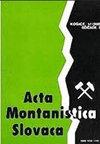电厂采出的松质灰级分的特性及其进一步利用
IF 1.4
4区 地球科学
Q2 GEOSCIENCES, MULTIDISCIPLINARY
引用次数: 1
摘要
大大小小的树突燃烧电厂都委托企业对其进行管理,保证其生态处理。为了确定如何正确处理或进一步利用树状体灰分,本文对某电厂废木材燃烧产生的各种渣和飞灰组分进行了分析和比较。该工厂每年产生约660吨灰废物。燃烧效率取决于季节、树木质量和工厂操作条件。在冬季,炉渣和灰分中碳渣(未完全燃烧的木屑)的比例增加。除季节性残炭外,在烟道和旋风中捕获的碎渣和细灰的化学成分和物相相似(28-44 wt.% CaO;25 - 35%二氧化硅;~ 7%氧化铝;~ 5% K2O;~ 4.5%分别)。织物过滤器捕获的细灰含有较少的硅和氧化铝化合物(SiO2 <7%;~2%的Al2O3),而钾和硫以及氯化合物(约2%的Al2O3)的比例要高得多。k2o 13%;3.5%的年代;<1.5% Cl),易溶于水。所有的灰分在第一次与水接触时会产生强碱性浸出物。捕获灰的化学成分的差异促使人们考虑对个别馏分进行有效再利用的可能性。本文章由计算机程序翻译,如有差异,请以英文原文为准。
Characterisation of Dendromass Ash Fractions Captured in Power Plant with a View to their Further Utilization
Small and larger dendromass-burning power plants entrust the management of the ash waste to companies which guarantee its ecological disposal. In order to specify the correct disposal or further utilization of the dendromass ash, the various slag and fly ash fractions from a power plant combusting waste wood were analyzed and compared in this work. The plant produces approximately 660 t of ash waste/year. The efficiency of combustion depends on the season, dendromass quality and plant operating conditions. The proportion of carbon residue (incomplete burnt wood-chips) in slag and ash fractions increases in the winter months. Except for the seasonal carbon residue, the crumble slag and fine ashes captured in the flue channel and cyclone are similar in chemical composition and phase (28–44 wt.% CaO; 25–35% SiO2; ~7% Al2O3; ~5% K2O; ~4.5% MgO). The finest ash captured in the fabric filter contains less silicon and alumina compounds (<7% SiO2; ~2% Al2O3) and a significantly higher portion of potassium and sulphur, and chlorine compounds (approx. 13%K2O; 3.5%S; <1.5% Cl) which are well soluble in water. All ash fractions produce strongly alkaline leaches in first contact with water. The differences in the chemical composition of captured ashes provide an impulse for considering the possibility of effective re-utilization of individual fractions.
求助全文
通过发布文献求助,成功后即可免费获取论文全文。
去求助
来源期刊

Acta Montanistica Slovaca
地学-地球科学综合
CiteScore
3.60
自引率
12.50%
发文量
60
审稿时长
30 weeks
期刊介绍:
Acta Montanistica Slovaca publishes high quality articles on basic and applied research in the following fields:
geology and geological survey;
mining;
Earth resources;
underground engineering and geotechnics;
mining mechanization, mining transport, deep hole drilling;
ecotechnology and mineralurgy;
process control, automation and applied informatics in raw materials extraction, utilization and processing;
other similar fields.
Acta Montanistica Slovaca is the only scientific journal of this kind in Central, Eastern and South Eastern Europe.
The submitted manuscripts should contribute significantly to the international literature, even if the focus can be regional. Manuscripts should cite the extant and relevant international literature, should clearly state what the wider contribution is (e.g. a novel discovery, application of a new technique or methodology, application of an existing methodology to a new problem), and should discuss the importance of the work in the international context.
 求助内容:
求助内容: 应助结果提醒方式:
应助结果提醒方式:


